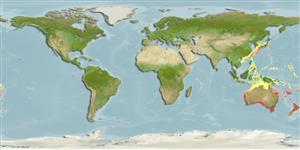| Native range | All suitable habitat | Point map | Year 2100 |

|
| This map was computer-generated and has not yet been reviewed. |
| Pagrus auratus AquaMaps Data sources: GBIF OBIS |
Length at first maturity
Lm 30.0, range 20 - 28 cm
Uso pelos humanos
Pescarias: espécies comerciais; Aquacultura: experimental; peixe esportivo: sim
Phylogenetic diversity index
(Ref. 82805)
PD50 = 0.5156 many relatives (e.g. carps) 0.5 - 2.0 few relatives (e.g. lungfishes)
Nível Trófico
(Ref. 69278)
3.6 ±0.2 se; Based on diet studies.
Resiliência
(Ref. 69278)
Baixo, tempo mínimo de duplicação da população 4,5 - 14 anos (tmax=11)